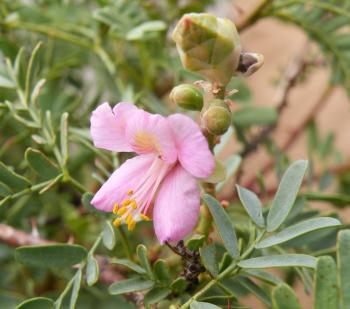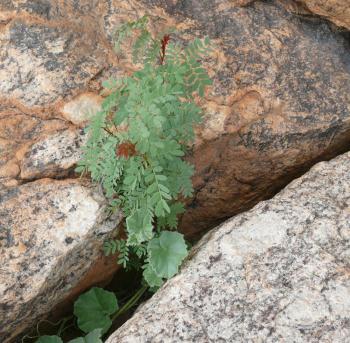Caesalpinia bracteata
Caesalpinia bracteata Germish.
Family: Fabaceae
Common names: Gariep plume-flower (Eng.); Gariep pronkstert (Afr.)
SA Tree No: 214.1
Introduction
Caesalpinia bracteata represents a fairly recent discovery. It is a rare, thorny shrub with beautiful pink flowers, endemic to the dry desert of the lower Orange River, in the Northern Cape and southern Namibia. It is easily grown from seed and an asset to desert and Karoo gardens.

Description
Description
Ascending multi-stemmed 1–2(3) m tall. Branches are renewed from the base, at first green, turning reddish and eventually greyish black and somewhat longitudinally fissured later. Stems are armed with straight to downward curving, white prickles, up to 11 mm long.

Leaves are divided (bipinnate): leaflets 4–6 pairs per pinna, opposite to almost opposite, narrowly oblong to elliptic, 3–11 × 2–5 mm, rounded at the tips, with the tip ending in a point. Young leaves are reddish, soon becoming olive-green, smooth (without hairs) or slightly hairy on both surfaces or only along the midrib. Both sides of the leaves with densely dark gland-dots. The leaf stalk is 4–16 mm long.

The inflorescence is a simple raceme, up to 60 mm long, with conspicuous, purple-pink bracts, almost rounded, ending in a sharp point and soon deciduous. Flowers are purple-pink, the sepals 5, dark maroon, conspicuously veined on the inside, the lower sepal larger and forming a hood over the other sepals. Petals 5, free to the base, obovate, up to 12 mm long and 8 mm wide. Stamens 10, up to 10 mm long; filaments pink, white, up to 1.5 mm long. Ovary glabrous. Pods compressed, broadly oblong-ovoid, beaked, 15–22 × 10–15 mm, maroon-brown, hard and woody glabrous. Seed more or less, maroon-brown. (Based on Germishuizen 1991).

With sufficient rainfall, Caesalpinia bracteata will flower almost throughout the year. However, most plants in habitat flower from July to April.
Conservation Status
Status
Caesalpinia bracteata is a rare species, known to occur over a small area and consists of fewer than 1 000 mature individuals. It is assessed in the Red List of South African plants as Vulnerable (VU). (Victor, Desmet & Van Wyk 2005).

Distribution and habitat
Distribution description
Caesalpinia bracteata is a rare shrub confined to the Naros granitoid geological formation (Miller 1980; Visser 1984; Van Wyk & Smith 2001). It is only known from between Pella in the east and Onseepkans in the west, along the Orange River of the Northern Cape and also from Namibia on the opposite side of the river, on the farm Naros. The vegetation consists of semi-desert and the vegetation named as Lower Gariep Broken Veld (Bushmanland Bioregion of the Nama-Karoo Biome) (Mucina & Rutherford 2006).
Plants share their habitat with species such as wild abutilon (Abutilon pycnodon), camel thorn (Vachellia erioloba), black thorn (Senegalia mellifera), butterflyleaf (Adenolobus garipensis), shepherd’s tree (Boscia albitrunca), smelly shepherd's tree (Boscia foetida), leafless wormbush (Cadaba aphylla), karee corkwood (Commiphora gracilifrondosa), Namaqua jackalberry (Diospyros acocksii), Namaqua fig (Ficus cordata), bell spikethorn (Gymnosporia tenuispina), river spiderbush (Maerua gilgii), Chinese lanterns (Nymania capensis), green-hair thorn (Parkinsonia africana), desert broom (Sisyndite spartea), and the buffalo thorn (Ziziphus mucronata). Rainfall is mainly in summer and consists of thunder showers and is below 100 mm per annum. Temperatures are high especially during the summer months, when it is often above 40ºC. Winters are warm and frost a rarity.

Derivation of name and historical aspects
History
Caesalpinia bracteata was first found by Andrew Gubb (1950–), the curator of the McGregor Museum, Kimberley (Northern Cape) on 8 July 1982 between the farms Yas and Warmbad, in the Northern Cape. It was found in the vicinity of the Orange River, South Africa’s largest river (Glen & Germishuizen 2010). Andrew collected herbarium specimens which he deposited at the McGregor Museum and a duplicate was sent to the National Herbarium in Pretoria. The next collections, 29 September 1987 and again in 1990, were those of Estelle van Hoepen (née Wasserfall), botanist from the then Botanical Research Institute. Gerrit Germishuizen, botanist from the former Botanical Research Institute, realising it was a new species, named it C. bracteata in 1991 in the botanical magazine Bothalia. The large floral bracts separating it from C. rostrata (Germishuizen 1991) from southern Namibia. Seeds were also collected by the author along the way during an excursion to Kaokoveld in June/July 2001. After consulting with one of the farm owners, Sakkie van Staden, the farm Skroef was visited on 23 July 2001, together with Tielman Haumann, where Caesalpinia bracteata was commonly encountered, and not far from the Orange River. On a subsequent expedition to Skimmelberg in southern Namibia in 2011, the farm Naros was visited, after consulting with the owner, to see if the plant also grew on the northern side of the Orange River in Namibia and, indeed, as we predicted, C. bracteata was encountered in crevices of Naros granitoid rock, representing the first record of C. bracteata for Namibia. The record further east at Pella, was collected by the ecologist Phillip Desmet.
Established by Linnaeus in 1753, Caesalpinia represents a large genus of more or less 200 species, most of which are confined to the New World (Heywood 1978). Caesalpinia honours the Italian botanist, Andreas Caesalpini (1519–1603) (Jackson 1990; Clark & Charters 2016). The species name bracteata, pertains to the large bracts protecting the flowers of C. bracteata. Many species are scrambing, bearing colourful flowers and many of which have been taken up in ornamental horticulture.
Southern Africa has 10 species of Caesalpinia of which 4 have been introduced and are invasive (Germishuizen 2001). The other 6 are indigenous to southern Africa (C. bonduc, C. bracteata, C. merxmuellerana, C. pearsonii, C. rostrata and C. rubra). The last four are confined to dry regions of Namibia. The Mauritius thorn (Caesalpinia decapetala), bird-of-paradise (C. gilliesii), C. pulcherrina and C. spinosa are invasive (Henderson 2001). Probably the best known is the bird-of-paradise (C. gilliesii), which is common in the Northern Cape.

Ecology
Ecology
Little is known about the pollination of Caesalpinia bracteata. The pollinators are insects and very possibly it is bees, especially the honey-bee. The seed has a very hard coat and adapted to germinating in crevices of the Naros granitoid rocks. Plants grow scattered on rocky outcrops, often in crevices or Naros granitoid rocks, always in full sun, and are locally common. The stems are erect and the prickles on the stem protects the plant from herbivores. With disturbances such as fire, the shrub will simply resprout.
Uses
Use
Only horticultural use is known.
Growing Caesalpinia bracteata
Grow
Caesalpinia bracteata shows horticultural promise for semi-arid to arid gardens and is best suited for Karoo and Desert gardens (Van Jaarsveld 2010). Sow in a sandy soil mixture in spring or summer. Germination should be within 3 weeks. Transfer to individual containers when big enough to handle. Best to treat the seed with a fungicide or fungal inoculant before sowing. Young plants have been established in the Botanical Society Conservatory at Kirstenbosch National Botanical Garden in 2002, from seeds collected by the author on the farm Skroef in the Northern Cape, where the plants can be seen. It flowered for the first time 6 years after sowing. Plants given to Kevin Koen, horticulturist from Calitzdorp Klein Karoo, planted them in his succulent Karoo garden with great success, flowering annually.
References
- CLARK, H. & CHARTERS, M. 2016. The illustrated dictionary of southern African plant names. Jacana Media, South Africa
- GERMISHUIZEN, G. 1991. Caesalpinia bracteata, a new species from the Onseepkans area of the Northern Cape Province. Bothalia 21,2: 152–154.
- GERMISHUIZEN 2001. Caesalpinia rostrata. Flowering Plants of Africa 57: 70–74.
- Germishuizen, G. & Meyer, N.L. (eds) 2003. Plants of southern Africa: an annotated checklist. Strelitzia 14. National Botanical Institute, Pretoria.
- Glen, H.F. & Germishuizen, G. (compilers). 2010. Botanical exploration of southern Africa, edition 2. Strelitzia 26. South African National Biodiversity Institute, Pretoria.
- HENDERSON, L. 2001. Alien weeds and invasive plants. Plant Protection Research Institute, Agricultural Research Council, Pretoria.
- HEYWOOD, V.H. (ed.). 1978. Flowering plants of the world. Oxford University Press, Oxford, London, Melbourne.
- Jackson, W.P.U. 1990. Origins and meanings of names of South African plant genera. University of Cape Town.
- LINNAEUS, C. 1753. Species plantarum. Facs. 1957. Ray Society, London.
- MENDELSOHN, J., JARVIS, A., ROBERTS, C. & ROBERTSON, T. 2002. Atlas of Namibia. Philip, Cape Town.
- MILLER, R. McG & SCHALK, K.E.L. 1980. Geological map of South West Africa/Namibia. Geological Survey of the Republic of South Africa and South West Africa/Namibia.
- MOORE, S. 1880. Enumeratio Acanthacearum. Journal of Botany, British and Foreign, London 18: 198.
- Mucina, L. & Rutherford, M.C. (eds) 2006. The vegetation of South Africa, Lesotho and Swaziland. Strelitzia 19. South African National Biodiversity Institute, Pretoria.
- Raimondo, D., Von Staden, L., Foden, W., Victor, J.E., Helme, N.A., Turner, R.C., Kamundi, D.A. & Manyama, P.A. (eds) 2009. Red list of South African plants. Strelitzia 25. South African National Biodiversity Institute, Pretoria.
- Van Jaarsveld, E.J. 2010. Waterwise gardening in South Africa and Namibia. Struik, Cape Town.
- VAN WYK, A.E. & SMITH, G.F. 2001. Regions of floristic endemism in southern Africa. A review with emphasis on succulents. Umdaus Press, Hatfield, Pretoria.
- VICTOR, J.E., DESMET, P.G. & VAN WYK, A.E. 2005. Caesalpinia bracteata Germish. National Assessment: Red List of South African plants version 2015.1. Accessed on 2017/01/16.
- Visser, D.J.L. 1984. Geological map of the Republics of South Africa, Transkei, Bophuthatswana, Venda and Ciskei and the Kingdoms of Lesotho and Swaziland. Government Printer, Pretoria.
Credits
Ernst van Jaarsveld
Kirstenbosch National Botanical Garden (Retired)
Babylonstoren Farm
Extraordinary senior lecturer and researcher, Department of Biodiversity and Conservation, University of the W. Cape.
January 2017
Plant Attributes:
Plant Type: Shrub
SA Distribution: Northern Cape
Soil type: Sandy
Flowering season: Sporadic/All year
PH: Neutral
Flower colour: Pink
Aspect: Full Sun
Gardening skill: Easy
Special Features:
Horticultural zones








Rate this article
Article well written and informative
Rate this plant
Is this an interesting plant?
Login to add your Comment
Back to topNot registered yet? Click here to register.